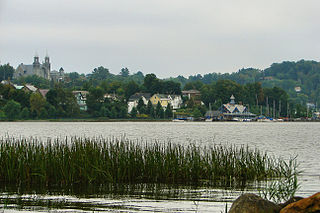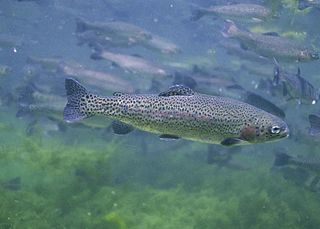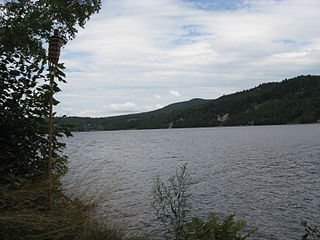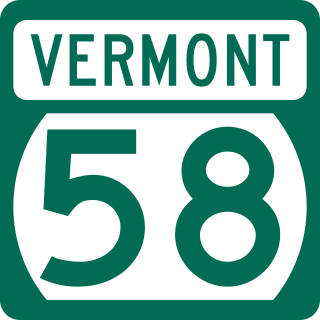Natural history
Willoughby is listed as a National Natural Landmark. [7] [8] Willoughby contains rainbow trout (wild and stocked), lake trout, landlocked Atlantic salmon (mainly stocked), rainbow smelt, burbot, yellow perch, longnose sucker, white sucker, lake chub, common shiner, and round whitefish which is a native species of extremely limited distribution in Vermont. Steelhead trout (rainbow trout) are not native to the region, but were imported to Lake Memphremagog from the Pacific Northwest. They migrate up the Barton River and Willoughby River to the lake to spawn. [9]
The sheer cliffs of Mount Pisgah and Mount Hor provide an environment conducive for arctic and cliff-alpine plants, as well as ideal nesting areas for the rare peregrine falcon. [10]
More than 100 bird species have been recorded around the lake including thrushes, warblers, hummingbirds, jays, finches, loons, herons and gulls. [11]

Orleans County is a county located in the northeastern part of the U.S. state of Vermont. As of the 2020 census, the population was 27,393. Its shire town is the city of Newport. The county was created in 1792 and organized in 1799. As in the rest of New England, few governmental powers have been granted to the county. The county is an expedient way of grouping and distributing state-controlled governmental services.
Orleans is a village in the northwestern corner of Barton, Orleans County, Vermont, United States. With a population of 788 at the 2020 census, it is the largest village in the county.

Westmore is a town in Orleans County, Vermont, United States. The population was 357 at the 2020 census, making it the least populated and least densely populated town in the county. The town contains one unincorporated village clustered around Lake Willoughby.

Barton is a town in Orleans County, Vermont, United States. The population was 2,872 at the 2020 census. The town includes two incorporated villages, Barton and Orleans. Approximately a quarter of the town's population lives in each of the villages, and approximately half lives outside the villages. Only four other towns in the state contain two incorporated villages.

Newport is the only city in, and the shire town of, Orleans County, Vermont, United States. As of the 2020 Census, the population was 4,455. The city contains the second-largest population of any municipality in the county, and has the smallest geographic area. It is the second-smallest city by population in Vermont. Newport is also the name of neighboring Newport Town.

The rainbow trout is a species of trout native to cold-water tributaries of the Pacific Ocean in Asia and North America. The steelhead is an anadromous (sea-run) form of the coastal rainbow trout(O. m. irideus) or Columbia River redband trout (O. m. gairdneri) that usually returns to freshwater to spawn after living two to three years in the ocean. Freshwater forms that have been introduced into the Great Lakes and migrate into tributaries to spawn are also called steelhead.
Steelhead, or occasionally steelhead trout, is the common name of the anadromous form of the coastal rainbow trout (Oncorhynchus mykiss irideus) or Columbia River redband trout. Steelhead are native to cold-water tributaries of the Pacific basin in Northeast Asia and North America. Like other sea-run (anadromous) trout and salmon, steelhead spawn in freshwater, smolts migrate to the ocean to forage for several years and adults return to their natal streams to spawn. Steelhead are iteroparous, although survival is approximately 10–20%.

Trinity Lake, previously called Clair Engle Lake, is an reservoir on the Trinity River formed by the Trinity Dam and located in Trinity County, California, United States. The dam was built by the U.S. Bureau of Reclamation. The lake's capacity is 2,447,650 acre⋅ft (3,019.13 GL), making it one of the largest reservoirs in California. The lake's surface is at 2,370 ft (720 m) above MSL. Trinity Lake captures and stores water for the Central Valley Project, which provides the Central Valley with water for irrigation and produces hydroelectric power. This lake is known for its many small arms, glassy inlets, and good water-skiing conditions.

Lake Memphremagog is a fresh water glacial lake located between Newport, Vermont, United States and Magog, Quebec, Canada. The lake spans both Quebec and Vermont, but is mostly in Quebec. Most of the watershed that feeds the lake is located in Vermont, and is a source for accumulated phosphorus, sediments, and other pollutants. Cleanup efforts since the late 1980s have improved the water quality. The lake furnishes potable water for 200,000 people.

Vermont Route 16 (VT 16) is a 27.890-mile-long (44.885 km) state highway in northern Vermont, United States. It begins at VT 15 in Hardwick and heads northward to U.S. Route 5 (US 5) in Barton. From Barton, it heads eastward to VT 5A in Westmore. The portion of VT 16 east of US 5 is town-maintained and signed east–west. The remainder of the route is signed north–south.

Crystal Lake is located near the village of Barton in Orleans County, Vermont, United States. It is a glacial lake 3 by 1 mile and 100 feet (30 m) deep in places. Route 5 runs along the lake's western shore. Crystal Lake is in the northeastern section of the state of Vermont. The lake is owned by the state and managed by the Department of Environmental Conservation.

Vermont Route 58 (VT 58) is a 30.908-mile (49.742 km) east–west state highway in Franklin and Orleans counties in northern Vermont, United States. The western terminus of the route is at VT 118 in Montgomery. The eastern terminus of VT 58 is at VT 5A north of Westmore and Lake Willoughby. In Orleans, VT 58 runs concurrent to U.S. Route 5 for a short distance, interchanging with Interstate 91 (I-91) at exit 26 during that interval. The portion of VT 58 west of VT 100 in Lowell is town-maintained. This section is a dirt road and is closed during the winter months because it goes through Hazens Notch.

Mount Pisgah is a mountain in Westmore, Vermont. It is located on the east side of Lake Willoughby and constitutes the eastern side of "Willoughby Gap". It is part of the Northeastern Highlands of Vermont. There are hiking trails in Willoughby State Forest.

The Barton River is a tributary of Lake Memphremagog, over 22 miles (35 km) long, in northern Vermont in the United States.
The Clyde River is a tributary of Lake Memphremagog, over 33.5 miles (54 km) long, in northern Vermont in the United States. It is the easternmost of the four major rivers in Orleans County. It is the most powerful of the four within Orleans County, powering several turbines at damsites. It is part of the Northern Forest Canoe Trail.

Echo Lake is located in the town of Charleston in Orleans County, Vermont within a region known as the Northeast Kingdom. It is one of only two deep, cold, and oligotrophic lakes in the Clyde River system, the other being nearby Lake Seymour. The first Surveyor General of Vermont, Whitelaw, gave it the name of Echo Pond because when any sound was produced in its vicinity it was reverberated in various directions, producing a series of echoes.
The Willoughby River is a tributary of the Barton River, flowing on 18.6 km (11.6 mi), in the Orleans County, Vermont, United States.
The Brownington Branch is a tributary of the Willoughby River, flowing in Orleans County, Vermont, in northern Vermont, in United States.

Willoughby State Forest covers 7,682 acres (31.09 km2) in Newark, Sutton and Westmore in Caledonia and Orleans counties in Vermont. The forest is managed by the Vermont Department of Forests, Parks, and Recreation. Activities include hiking, primitive camping, cross country skiing, snowshoeing, hunting and fishing.


















